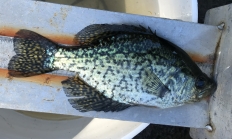
Search myodfw.com
Find maps, boundary descriptions and the percent public land for the Silver Lake Unit.
Find maps, boundary descriptions and the percent public land for the Siuslaw Unit.
Find maps, boundary descriptions and the percent public land for the Sprague unit.
Find maps, boundary descriptions and the percent public land for the Whitehorse Unit.
Find maps, boundary descriptions and the percent public land for the Columbia Basin Unit.
Find maps, boundary descriptions and the percent public land for the Interstate Unit.
Find maps, boundary descriptions and the percent public land for the Keno Unit.
Find maps, boundary descriptions and the percent public land for the Klamath Falls Unit.
Find maps, boundary descriptions and the percent public lands for the Northside Unit.

Find maps, boundary information and the percent public land in the Powers Unit.
Features: Black crappie are silvery in color with numerous black or dark green blotches and no distinct vertical bars. This results in a darker overall color than seen in white crappie. The forehead is dished, but not as much as in the white crappie. The dorsal fin usually has seven or eight spines and its length is equal to or greater than the distance between the dorsal fin and eye. Habitat: Black crappie do best in clear waters of medium-sized lakes, reservoirs and large slow moving streams. They are less tolerant of flowing and muddy water than white crappie and

Features: White crappie are often confused with black crappie. White crappie have silvery bodies with blackish-green mottling forming narrow vertical bars on the sides. The forehead is more dished than in the black crappie. The dorsal fin has five or six spines and its length is less than the distance between the dorsal fin and eye. Habitat: White crappie do best in larger lakes and reservoirs and are more tolerant of turbidity and less dependent on aquatic vegetation than black crappie. They congregate around pilings, sunken logs, underwater brush, weed beds and rocks. White crappie begin life feeding primarily on

Shooting a target while standing up at the range is a lot different from shooting a turkey while sitting in a ground blind. When practicing for a hunting trip, recreate your shooting scenario. Whether it will be standing, sitting, kneeling, and in or out of a ground blind. Shooting a turkey There ’s no substitute for practicing in conditions that closely resemble those you’ll be hunting in, and this is especially true for bowhunters looking to bag a turkey. Turkeys are nervous birds with very small kill zones, so accurate shot placement is critical for getting a quick, clean kill

Find maps, boundary descriptions and the percent public lands in the Sumpter Unit.

Find maps, boundary descriptions and the percent public lands in the Ukiah Unit.
Find maps, boundary descriptions and the percent public land in the Biggs Unit.
Find maps, boundary descriptions and the percent public land for the Heppner Unit.
Find maps, boundary descriptions and the percent public land for the Pine Creek Unit.
Find maps, boundary information and the percent public land in the Rogue Unit.

